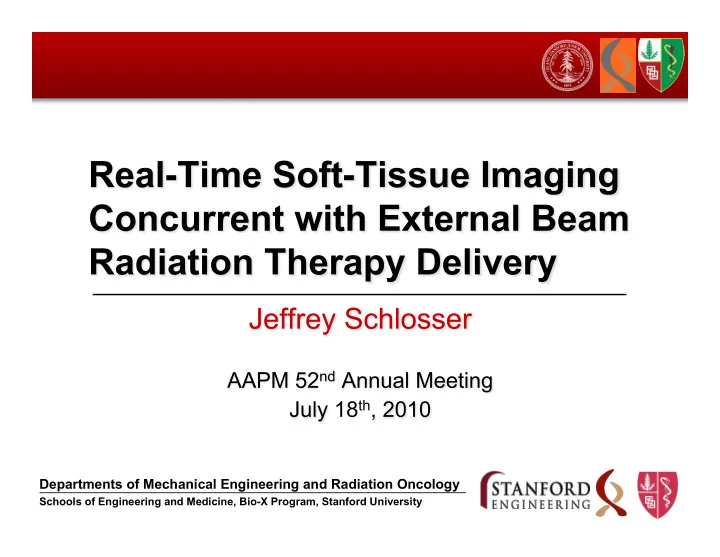

Departments of Mechanical Engineering and Radiation Oncology 1 Schools of Engineering and Medicine, Bio-X Program, Stanford University
Imaging During Beam Delivery • Existing solutions are limited: Radiographic x-ray Electromagnetic Real-time marker-less soft-tissue image guidance during beam delivery is an unmet challenge 2
How about ultrasound? • Previous investigations use imaging prior to delivery, or imaging in phantoms – A. Hsu, N. R. Miller, P. M. Evans et al., "Feasibility of using ultrasound for real-time tracking during radiotherapy," Medical physics 32 (6), 1500-1512 (2005). – Q. Xu and R. J. Hamilton, "A novel respiratory detection method based on automated analysis of ultrasound diaphragm video," Medical physics 33 (4), 916-921 (2006). – E. J. Harris, N. R. Miller, J. C. Bamber et al., "Performance of ultrasound based measurement of 3D displacement using a curvilinear probe for organ motion tracking," Physics in medicine and biology 52 (18), 5683-5703 (2007). – A. Sawada, K. Yoda, M. Kokubo et al., "A technique for noninvasive respiratory gated radiation treatment system based on a real time 3D ultrasound image correlation: a phantom study," Medical physics 31 (2), 245-250 (2004). – F. Jacso, A. Kouznetsov, and W. L. Smith, "Development and evaluation of an ultrasound- guided tracking and gating system for hepatic radiotherapy," Med Phys 36 (12), 5633-5640 (2009). Unresolved Question: How can we control the US imaging process during beam delivery from outside the treatment room? 3
Novel Image Guidance Solution Linear Accelerator Accelerator control console 4D US probe Optical tracker Intervention Patient Treatment Haptic Interface US US-guidance workstation Robot computer Robot Control 3D US image stream US imaging system Probe position data (6 DOF) 4 Telerobotic system enables remote probe control
Key Issues • Design of customized robotic manipulator – Range of motion – Radiotherapy environment constraints – Human safety • Robustness of telerobotic human imaging • Treatment plan compatibility • Performance during radiation exposure 5
Robot Design Specs • Range of motion – Optical tracking – Probe pitch critical: 0-45° • Radiotherapy environment constraints – 360 degree gantry rotation – Limited mounting areas on treatment couch – Limited clearance between patient and LINAC head 6
Manipulator Design R3 Load Cell R2 R2 R5 R4 P1 z y R5 R4 P1 P1 z z Blue = Locking Joint Blue = Locking Joint Red = Actuated Joint Red = Actuated Joint R3 y y x x R2 y R4 R5 R4 x RCM 7 Critical motions are actively controlled during treatment
Telerobotic Imaging Remote Haptic Interface Robot 8
Telerobotic Imaging Volunteer #1 Volunteer #2 Volunteer #3 Pitch Force 9 Image quality remotely maintained over 10 minutes
Impact on Treatment Plan PTV PTV Rectum Rectum GTV GTV Bladder Bladder Clinical prostate IMRT plan Re-optimized IMRT plan with restricted beam angles to avoid US probe and robot links Re-optimized plan with 2mm margin reduction as potentially enabled by real-time image guidance Plans are nearly identical. Potential margin reduction from real-time guidance is beneficial. 10
Performance During Delivery Beam Off Beam On Probe 0mm Probe 16mm p-Value p-Value Servo cycle interval 0.99 0.99 Force control 0.46 0.46 Pitch tracking error 0.47 0.47 US tracking error 0.68 0.68 11 LINAC interference inconsequential for robot and US
Conclusion Telerobotic ultrasound imaging is feasible during beam delivery + = Could provide non-invasive guidance that truly reflects soft tissue anatomy 12
Questions? • Email: jschlosser@stanford.edu Departments of Mechanical Engineering and Radiation Oncology 13 Schools of Engineering and Medicine, Bio-X Program, Stanford University
Recommend
More recommend